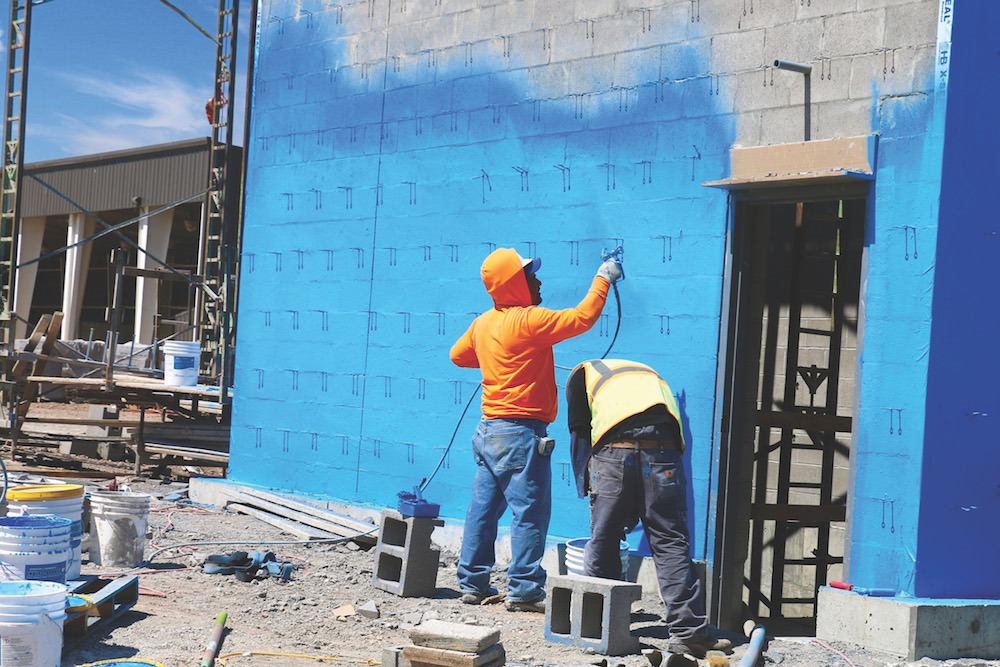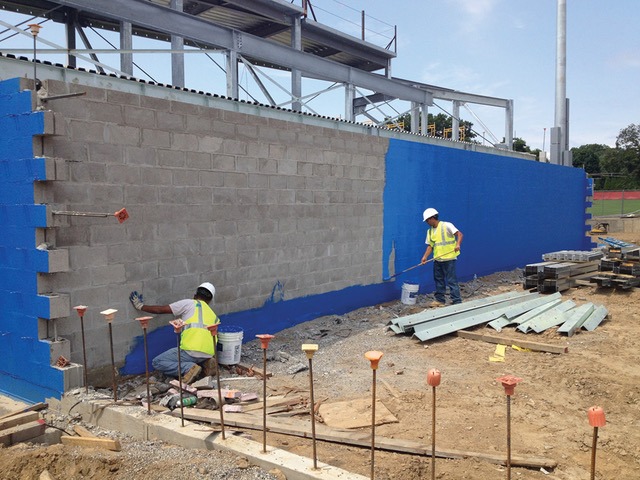Controlling the Wall System
Words: Jeremy Douglas
Look beyond brick and mortar for opportunities to expand your bid package
Words: Jeremy Douglas
The specific application of a building’s air barrier system can be confusing. As a mason contractor, understanding the purposes of these systems and how they critically interface to adjacent materials reveals how simple they actually are. In short, you may be missing out on providing a critical component of the masonry wall system.
First, it is important to define what an air barrier is. Installed on the exterior face of the backup wall, an air barrier is a water-resistive barrier that stops the movement of air. If designed to do so, it may also act as the vapor barrier. An air barrier is often mistakenly referred to as a “waterproofing” system. While an air barrier system may have similar physical properties or application methods of a waterproofing system, the two systems are completely independent of one another. Think of your air barrier, instead, as air-proofing your wall system.
Why you should care
It is easy to focus only on your existing areas of expertise and experience, allowing the air barrier system portion of the work to be subbed out to another contractor. We tend to shy away from accepting added responsibilities, fearing additional liabilities. In the case of air barrier systems, however, understanding them more clearly may actually protect you. Forget the notion of repelling any legal responsibilities. As the mason contractor, you will undoubtedly be the first person called, should a failure ever present itself anywhere within or adjacent to the wall structure – even when your work is sound. That’s why it is paramount that you retain control over as much of the wall system as possible.
In most cases, interfacing some other product with the air barrier system is necessary (think flashing materials, anchors, z-girts, etc.). A better knowledge of the air barrier system can only help to ensure a successful installation and result in a wall system that will provide a longevity of service to match the design intent.
An understanding of air barrier systems also means compatibility issues between the barrier and the flashing material or sealant that will adhere to it are limited or fully eliminated. If a contractor’s focus is solely on laying brick into bed joints and ignoring the air barrier system, that system’s integrity will be compromised.
The field area of the air barrier is usually either a fluid-applied or a self-adhering sheet material that runs continuously around the entirety of the building – all sides, connecting the barrier to the below-grade waterproofing and the roofing system – and isolating the openings. Either type of system will incorporate transition detailing for standard conditions, like window or door openings and mechanical penetrations, or transitioning to other adjacent systems. The end result should be as close to a monolithic barrier as possible, with no breaches, to completely prevent the leakage of air into or out of the wall assembly.
Most mason contractors lacking experience in air barrier systems would be more comfortable covering a building in a 36-inch-wide, self-adhering membrane than with a fluid-applied coating.
While self-adhering membranes can be effective as air barriers, they probably aren’t the most efficient for successful installation. Fluid-applied systems tend to install quickly and simplify the verification of its continuity. Ensuring there are no voids, gaps or fish-mouth gaps in the seams of the self-adhering sheet systems is a little more daunting – not impossible, but difficult.
 Manufacturer’s installer programs are available to show you how to detail specific project conditions.
Manufacturer’s installer programs are available to show you how to detail specific project conditions.
In the design phase of a project, the recommendation is almost always made for a fluid-applied system, unless the project scope is small enough that dragging spray equipment doesn’t make a whole lot of sense. For CMU backup walls, only fluid-applied systems are appropriate to ensure adhesion to the substrate and to ease detailing around masonry wire anchoring systems.
The equipment for applying fluid-applied barrier systems can be the greatest obstacle to overcome. Many first-time fluid-applied air barrier applicators look to using paint rollers or brushes, or submit self-adhering membranes as substitutions for the specified fluid products. From a labor perspective, this is a mistake. Roller application of a fluid-applied membrane is incredibly time consuming as it will require multiple passes. And, it is almost impossible to accurately gauge the thickness of the coating during the application.
Using a spray rig, instead, allows for a much faster application with better continuity of the field applied area. These spray set-ups come in many different sizes, can be either gasoline- or electric-powered configurations, and may have the option to run multiple hoses for quick coverage across the wall surface. Maintenance of these machines is usually minimal, provided they are cleaned immediately after use, with an occasional deeper cleaning.
Small rigs, only a little larger than a pressure wash machine, are available and can be lifted easily into a truck bed. An initial investment for this equipment can be as little as a few thousand dollars. Renting a rig is also an option.
 The right equipment can ease installation, keeping the air barrier installation profitable.
The right equipment can ease installation, keeping the air barrier installation profitable.
The know-how
Still apprehensive? Multiple opportunities exist for good training on the general applications of these systems. The Air Barrier Association of America (ABAA) offers installer certification programs and quality control certifications. ABAA certification also is available through the International Masonry Institute, which goes above and beyond ABAA requirements by demonstrating practical application and common field conditions.
Air barrier product manufacturers often will provide trainings that should show not only how the products are to be applied, but also how the product should be detailed in the field in various conditions. This training is invaluable, as that manufacturer will, undoubtedly, be a resource for you in the field for many projects in the future.

To recap: Air barrier systems are critical components of wall systems. The successful installation of these systems is inevitably tied to your portion of the work, whether or not you choose to be the installer. Many resources are available to installers to help ensure successful application, so don’t go it alone. The equipment to install these systems is a lot simpler than it seems.
So don’t be afraid to broaden your scope of work. Become a contractor who specializes in the entirety of the building envelope. It leads to more work and, ultimately, more revenue.
Jeremy Douglas, CSI, CCPR, is the Director of Architectural Services for Hohmann & Barnard, H-B.com. Jeremy serves as the primary technical resource to the design community and is a national speaker and technical resource on the subjects of moisture control, building envelope systems, reinforcing and anchoring, and masonry restoration.